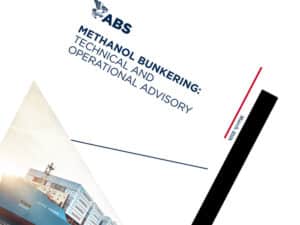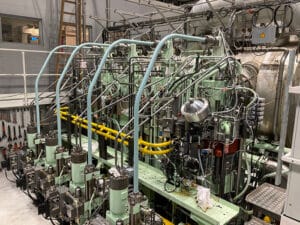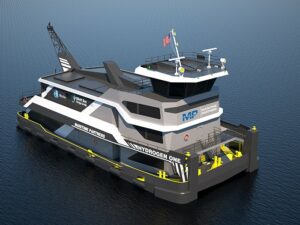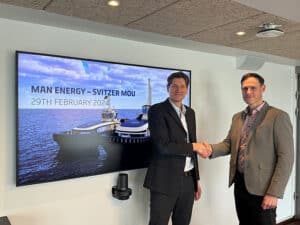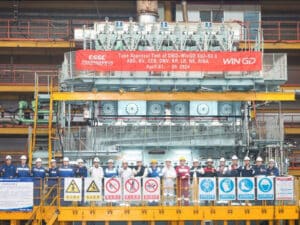
Marine engine design and the future fuels challenge
Written by Nick Blenkey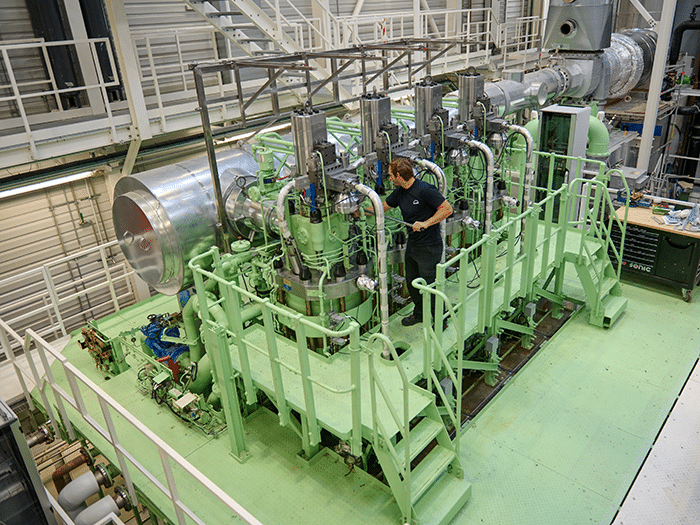
MAN's Research Center Copenhagen, with its two research engines, is playing a major part in the development of next-generation engines. (Credit: MAN Energy Solutions)
Any discussion of developments in marine engine design must start with fuels — notably future fuels because any ship ordered today will have an expected operating life of around 20 to 25 years with carbon-reduction requirements ramping up throughout those years.
Smart owners who are already ordering ships with notations such as “ammonia ready” aren’t just being environmentally altruistic. They’re protecting themselves against their vessels being unsaleable or uncharterable lemons when they reach middle age. We’ll look more closely at the future fuels themselves in our upcoming Green Issue in July. This time around, our focus will be on the steps, engine designers are taking to prepare for the new fuels and the progress they are making.
While LNG can now hardly be seen as a future fuel, engine companies continue to refine their offerings to reduce the level of methane slip in which a proportion of the potent global warming gas remains unburned in the combustion process. This is an issue mainly with low pressure, Otto-cycle engines.
While LNG offers an immediate reduction in CO2 emissions of up to 18%, it can never be more than a bridge to zero-carbon fuels. There are ways in which the bridge can be extended, and CO2 emissions lowered, but, ever since February 2021, when Maersk announced its plans to order its first containership powered by carbon neutral green methanol, more shipowners seem have reached the conclusion that methanol can offer all the carbon reductions benefits of LNG without all the expensive cryogenics needed to keep LNG liquefied. Similarly, the path to green methanol seems no more fraught than the path to renewable LNG.
Again, we’ll discuss what makes green methanol green at some other time. Here we’ll concentrate on the engines, where some notable deliveries and orders have been in the news.
MAN Energy Solutions’ Korean two-stroke licensee, HHI-EMD (Hyundai Heavy Industries – Engine and Machinery Division) this year completed world’s largest methanol-powered two-stroke engine, an MAN B&W G95ME-C10.5-LGIM, taking the company past 200 million brake-horsepower production mark.
HHI-EMD just happens to be the world’s largest manufacturer of marine engines and, in addition to producing two strokes under license, has its own very successful HiMSEN line of four-strokes. In December last year, in a world four stroke first, two sets of sets of HiMSEN H32DF-LM methanol dual fuel engines completed factory acceptance tests.
With a 95 centimeter bore size, the MAN B&W that took HHI-EMD past the 200 million bhp milestone, is the world’s first large bore methanol engine and will be installed on Maersk’s first methanol-fueled 16,000 TEU containership.
MAN Energy Solutions developed the ME-LGIM dual-fuel engine for operation on methanol, as well as conventional fuel. The engine is based on the company’s proven ME-series, with its approximately 8,500 engines in service, and works according to the diesel principle. When operating on green methanol, the engine offers carbon-neutral propulsion for large merchant-marine vessels. Currently more than 100 ME-LGIM engines are on order or in service, more than 50 of which are G95ME-C10.5-LGIM variants.
The first of Maersk’s 16,000 TEU methanol fueled box ships is set to enter services in 2024. China’s COSCO Shipping Lines has four methanol fueled box ships of the same size on order at COSCO Shipping Heavy Industry (Yangzhou) Co. Ltd. These ships will be powered by WinGD 10X92DF-M methanol-fueled engines.
The fourth vessel in the series will be the first to have methanol engines installed from the beginning. The earlier vessels will initially have methanol-ready X92-B engines installed and will be converted for methanol before entering service.
The X92DF-M engines will be based on the widely used WinGD X92-B engine and will utilize the same high-pressure diesel combustion cycle as the X-92B.
WinGD says the order will enable it to advance its timeline for developing conversion packages for methanol-fueled engine and that it will introduce a methanol package for the X92-B engine as soon as the fourth vessel in the series is delivered—opening the market for existing vessels with X92-B engines to be converted to use methanol.
While fossil methanol is a widely available and requires no special bunkering vessels, achieving carbon neutrality requires green methanol. Maersk has been ramping up agreements around the world to ensure its availability for its vessels.
Getting beyond carbon neutral
From an engine design perspective, getting to zero carbon fuels like ammonia and hydrogen is progression rather than a step change.
Both MAN Energy Solutions and WinGD are well advanced on their plans for ammonia-fueled two strokes and so too is the world’s other leading brand, Japan Engine Corporation (J-Eng), the developer and manufacturer of the long-running UE engine series, which last year reached the 40 million installed horsepower milestone.
MAN has said that it will have an ammonia fueled engine on the market in 2024. Playing an important part in this will be its Research Center Copenhagen, with its two research engines.
One breakthrough coming from the research center came in 2011 with introduction of the dual fuel two-stroke engine ME-GI – an engine capable of running on both gas and/or diesel. The world’s first LNG-fueled containership, the Isla Bella, was ordered in 2012 and delivered to Jones Act operator TOTE Maritime by NASSCO San Diego in 2015, powered by an 8L70ME-GI engine built under license by Korea’s Doosan Engine.
The GI gas injection technology opened the door for its development to work with ethane, methanol, and LPG. This, in turn, became the new basis for the next generation of larger methanol and soon, ammonia engines.
While using new fuels means that critical parts such as injectors, exhaust valves and even control systems will have to be modified, the aim is to find a design that only needs a few adjustments and add-ons.
WinGD has reached an agreement with Compagnie Maritime Belge’s cleantech group CMB.TECH on the development of ammonia-fueled two-strokes. The target is to install an ammonia dual-fuel X72DF engine on a series of ten 210,000 DWT bulk carriers to be built at a Chinese shipyard in 2025 and 2026.
Ammonia-fueled four-strokes are also not too far distant. In May, he Norwegian government’s Enova innovation agency announced it was providing in funding Skarv Shipping Solutions AS to acquire three cargo ships. Central to the project, says Enova, is the ammonia engine the ships will use. Wärtsilä has previously tested the engine technology at the Sustainable Energy Catapult Center in Stord, Norway, and aims to deliver it towards the end of 2024.
In Japan, J-Eng, whose main shareholders include Mitsubishi Heavy Industries (MHI), recently reported that, under a project backed by Japan’s Green Innovation Fund and New Energy and Industrial Technology Development Organization (NEDO) it has already carried out what it claims is the world’s first “zero-emission fuel” ammonia co-firing operation of a large low-speed two-stroke ship’s engine and has begun testing of a hydrogen fuel injection device for a large low-speed two stroke.
The ammonia-fueled test engine is installed at MHI’s Research and Innovation Center (Nagasaki) and has been fitted with J-Eng’s stratified injection system technology, using fuel oil as a pilot fuel.
Ammonia is a flame-retardant fuel, and stratified injection addresses this by injecting the ammonia fuel in such a way that it is sandwiched between the combustible pilot fuel and post fuel, making possible to achieve advanced combustion control, improve the ammonia co-combustion rate, and reduce the temperature.
J-Eng will operate the test engine with ammonia fuel under various conditions over the next year and aims to have a 50 centimeter bore, ammonia fueled UEC50LSJA engine completed in 2025. It then plans to launch the UEC60LSJA engine, an ammonia-fueled engine with a bore of 60 centimeters, which is optimal for a main engine, on the market after 2026 and has already started development of its oil-fired “twin,” the UEC60LSH engine, which is the successor model to the long running UEC60LSE engine.

